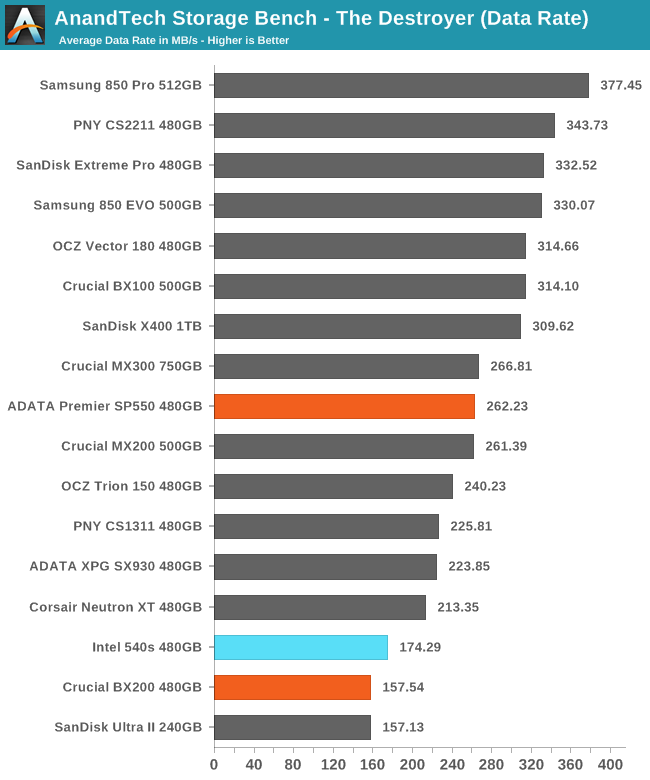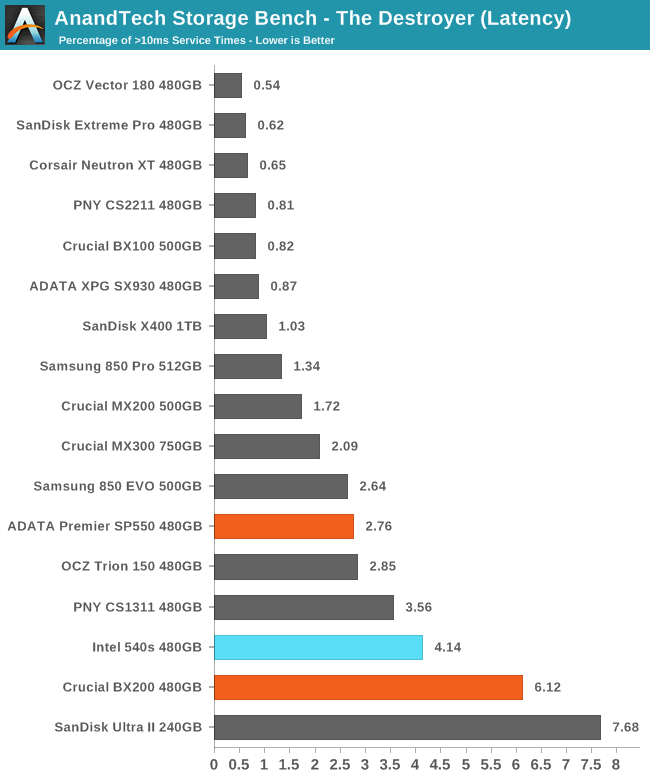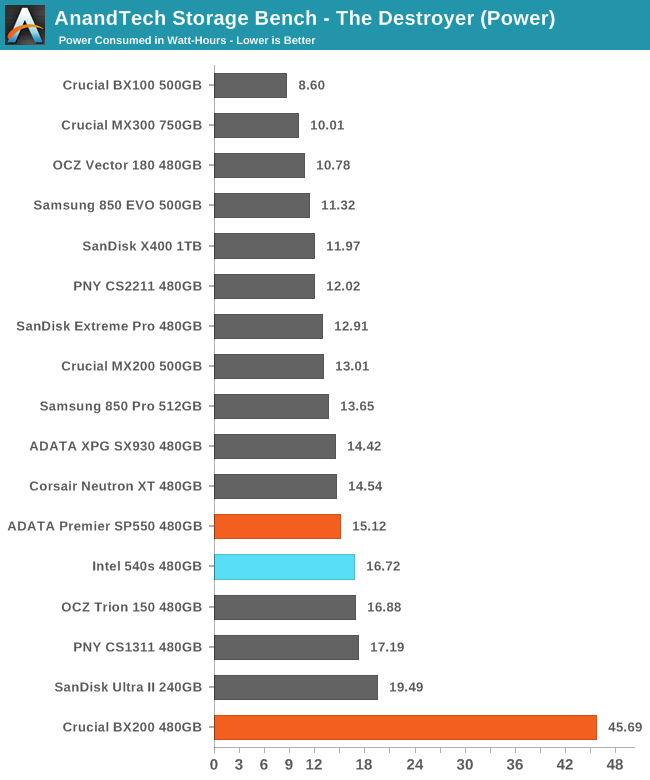The Intel SSD 540s (480GB) Review
by Billy Tallis on June 23, 2016 9:00 AM ESTAnandTech Storage Bench - The Destroyer
The Destroyer is an extremely long test replicating the access patterns of very IO-intensive desktop usage. A detailed breakdown can be found in this article. Like real-world usage and unlike our Iometer tests, the drives do get the occasional break that allows for some background garbage collection and flushing caches, but those idle times are limited to 25ms so that it doesn't take all week to run the test.
We quantify performance on this test by reporting the drive's average data throughput, a few data points about its latency, and the total energy used by the drive over the course of the test.

On The Destroyer, the ADATA SP550 was able to punch above its weight and perform on par with planar TLC drives of twice the capacity, while the Crucial BX200 performed below expectations. The Intel 540s unfortunately demonstrates more of the latter, with an average data rate that is not as bad as the BX200 but is still clearly outclassed by the Phison S10 TLC drives and the SP550.

As with the average data rate, the average service time of the 540s is poor but not quite as bad as the BX200. The SP550 didn't rank much higher on this metric, but in absolute terms it was significantly faster.


The frequency of latency outliers shows similar rankings, with the Intel 540s near the bottom of the chart and between the two SM2256 drives.

Power efficiency has regressed slightly compared to the SP550, but the Intel 540s clearly doesn't have anything horribly wrong going on the way the BX200 did.










77 Comments
View All Comments
Drasca - Tuesday, June 28, 2016 - link
There is a matter of scale. What is efficient for the small scale is not efficient for the large scale deployment.> even though it would probably save them a lot of dough
It wouldn't, it'd create the opposite effect costing them far more in the long run. You're thinking from the personal perspective where maintenence, reliability and security isn't an issue and non critical.
En mass, it costs them far more to have downtime, maintaining and replacing gear, than it does the initial purchase-- security notwithstanding either. They have to pay people time and money to keep the equipment up, whose price just snowballs as downtime accrues. The initial equipment cost is extremely fractional compared to the human resource cost of dealing with the equipment afterward, keeping track of it, security, physically replacing as it goes down, etc.
Buying from bulk also guarantees Hp/dell/lenovo has standardized problems and they replace the gear as it breaks wholesale. The equipment is closer to leased than purchased, with basically extended warranty guarantees. Consumer equipment does not have these protections and guarantees.
It costs far far far more in human resources spending time and money upkeeping a lot of gear that breaks, and all things will eventually break with this many pieces of equipment, taking up space that costs even more money, and causing a clusterfuck when you don't have government contracts.
The consumer level does not work at the government level and vice versa.
>entirely new workstation for that user.
They actually get entirely new workstations, for the most part. . . and old ones are worked to hell until budgets come in and approved for for upgrades across the board.
woggs - Thursday, June 23, 2016 - link
Intel doesn't ship unreliable drives (and will fix an issue if it slips out). That's the one thing you get from intel and is why they can get the big OEM orders. Other than that, I agree with "meh."trparky - Thursday, June 23, 2016 - link
For Christ's sake, why are we still using Planar NAND? Haven't we learned already that Flash memory at anything smaller than 19nm is just too unreliable? For God's sake! Everyone should be moving to 3D NAND already!trparky - Thursday, June 23, 2016 - link
Unless it's using 3D NAND, I won't buy it.ClockHound - Thursday, June 23, 2016 - link
3D? If it's not 4D, I'm not putting precious historically disposable data on it.chrcoluk - Sunday, July 17, 2016 - link
looks like its planar I am guessing by the small manufacturing size, one of the reasons ofr 3d nand is to use larger manufacturing process which has more reliable flash.16nm TLC is too scary for me.
euskalzabe - Friday, June 24, 2016 - link
Agreed. I was on the verge of buying a 512GB X400 but I think I'll wait until the fall, see what 3d NAND comes out...maxxbot - Thursday, June 23, 2016 - link
Who is this marketed for exactly? The X400 is faster AND cheaper, the 850 EVO is around the same price and much, much faster. It looks like you didn't even read the review.maxxbot - Thursday, June 23, 2016 - link
As for the reputable company comment, there's already a very reputable company out there that produces drives with much better price/performance: Samsung. Every corporate laptop I have had has had a Samsung SSD, why would they choose lower performance and higher price to go with this drive?alpha754293 - Monday, July 25, 2016 - link
Sadly though, my Intel 520 series SSDs performed better in random I/O (swapping) than this *NEW* Intel 540 series drive.The ONLY thing that has changed is cost. (I can buy a 1 TB 540 series drive at Microcenter for $250, and therefore; the $/GB has come down a LOT since the 520 series days), but for a 5-series drive, it certainly doesn't have the performance to match.
This was the same problem that I had with the 535 Series as well.
Whyyy would you release a NEW product that's actually inferior in measurable performance?
You would think that when you're buying a NEW drive, that you're getting the best that the company has to offer at this level. (Yes, I also have a 750 series PCIe x4 SSD as well, in case you were wondering (or not).)